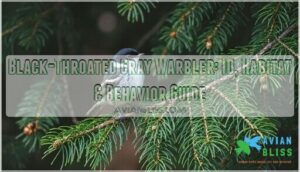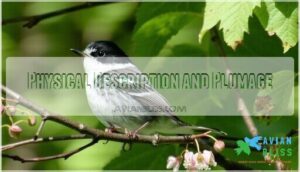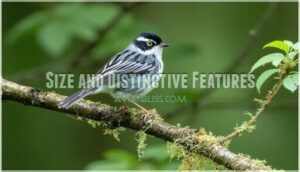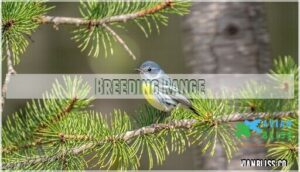This site is supported by our readers. We may earn a commission, at no cost to you, if you purchase through links.

These compact 4.5-inch warblers inhabit western North America’s pine forests and juniper woodlands from British Columbia to Mexico.
They’re fastidious hunters, gleaning caterpillars and spiders from branches with needle-sharp precision.
Their buzzy song rises through 4-6 notes before dropping on the final phrase.
Despite their "Least Concern" status, populations have dropped nearly 50% since 1970 due to habitat loss and climate shifts.
Spotting one requires knowing exactly where to look and what subtle field marks separate them from similar species.
Table Of Contents
- Key Takeaways
- Black-Throated Gray Warbler Identification
- Geographic Range and Habitat
- Behavior and Diet
- Conservation Status and Threats
- Birdwatching Tips for This Warbler
- Frequently Asked Questions (FAQs)
- What is a GREY bird with a black throat?
- What is the Black-throated Gray Warbler habitat?
- Where do black-throated blue warblers live?
- How rare is a black and white warbler?
- What is the average lifespan of a Black-throated Gray Warbler?
- How do Black-throated Gray Warblers defend their territory?
- What are the main predators of the Black-throated Gray Warbler?
- How do Black-throated Gray Warblers communicate with each other?
- How long do black-throated gray warblers live?
- What predators threaten these warbler species?
- Conclusion
Key Takeaways
- You’ll identify them by their striking "tuxedo" appearance – males display bold black throat patches against white cheeks and bellies, while females show more subtle gray tones with the same distinctive facial pattern.
- You’ll find them in western pine forests and juniper woodlands from British Columbia to Mexico, where they’re fastidious hunters gleaning caterpillars and spiders with needle-sharp precision.
- You’ll hear their distinctive buzzy song rising through 4-6 notes before dropping on the final phrase, making them easier to locate during breeding season from late April through July.
- You should know they’re declining despite "Least Concern" status – populations have dropped nearly 50% since 1970 due to habitat loss and climate shifts, making conservation awareness important for birders.
Black-Throated Gray Warbler Identification
You’ll recognize the Black-throated Gray Warbler by its striking monochrome appearance and distinctive facial markings that make it stand out among western warblers.
This small songbird displays clear sexual dimorphism, with males showing bold black throat patches and females exhibiting more subdued gray coloring.
Physical Description and Plumage
You’ll instantly recognize this warbler species by its striking black and white plumage patterns with distinctive gray warbler bird characteristics.
The striking black and white plumage instantly reveals this warbler’s identity among western woodlands
The black-throated gray warbler displays bold head markings featuring a black cap and throat patch contrasting sharply against white cheeks and eyebrow stripes.
Their feather texture appears smooth, while the compact beak shape suits their insectivorous lifestyle perfectly within warbler habitat environments.
The warbler’s physical traits, including its beak shape and size, are key factors in bird identification techniques.
Male Vs. Female Differences
You’ll notice distinct sex dimorphism in this warbler species through key plumage variations and color patterns.
Males showcase bold black throat patches and caps, while females display muted gray caps with reduced or absent throat markings.
Both sexes share similar beak shapes and retain white wing bars, though males exhibit stronger contrast in their black and white coloration throughout their range.
Size and Distinctive Features
You’ll find this compact warbler measures just 11-13 centimeters long, weighing only 7-10 grams—about the size of your thumb.
The black throated gray warbler’s plumage patterns create striking contrast through distinctive body proportions and feather length variations that make field identification straightforward.
Key Distinctive Features:
- Beak Shape – Thin, pointed bill perfect for insect gleaning
- Eye Color – Bright yellow spot directly in front of dark eyes
- Plumage Patterns – Bold black and white stripes with gray backing
- Body Proportions – Compact build with relatively long tail for balance
- Feather Length – White wing bars and outer tail feathers visible during flight
Geographic Range and Habitat
You’ll find Black-throated Gray Warblers across western North America, from British Columbia down through the Pacific Coast states to northern Mexico.
These adaptable birds prefer open woodlands like pine-oak forests, juniper stands, and chaparral habitats at middle elevations.
Breeding Range
The Black-throated Gray Warbler’s breeding range spans from southwestern British Columbia through the Pacific Coast to northern Baja California, extending eastward to New Mexico and central Wyoming.
You’ll find these gray warbler birds in open coniferous forests, pinyon-juniper woodlands, and chaparral with brushy understory.
Recent range expansion into Montana reflects climate-driven juniper habitat growth, with warbler nesting occurring in horizontal tree branches 2-35 feet high.
The warblers’ habitat selection is influenced by their preference for forest habitats and specific tree species.
Migration and Wintering Range
During migration, you’ll encounter these warblers following distinct flyway patterns through western mountain corridors.
Their migration routes span from British Columbia to Mexico, with stopover sites in pinyon-juniper woodlands. Winter habitats include dry Mexican forests below 1,500 meters elevation, where flocking behavior becomes prominent among mixed-species groups.
- Spring migration timing: Late March through May, peaking in late April
- Fall migration period: Mid-August through November along Pacific and mountain routes
- Primary winter range: Central to western Mexico, from Baja California to Oaxaca
- Mixed-species flocking: Common behavior with Townsend’s and Hermit Warblers during migration
- Vagrant records: Occasional eastward strays reaching Virginia and Georgia during fall movements
Understanding the warbler migration patterns is essential for effective birdwatching.
Preferred Habitats and Ecological Associations
These versatile warblers thrive across diverse western landscapes, from riparian forests along valley bottoms to expansive juniper woodlands at higher elevations.
You’ll encounter them in chaparral ecosystems, pine forests, and Douglas-fir stands—habitats that support their insect-rich diet while providing essential nesting sites.
Understanding gray warbler migration patterns and warbler behavior helps with warbler habitat preservation efforts protecting these critical ecosystems.
Behavior and Diet
You’ll observe Black-throated Gray Warblers actively searching for insects while delivering their distinctive buzzy songs from mid-forest perches.
These energetic insectivores specialize in gleaning caterpillars and other small insects from foliage, often joining mixed-species flocks during migration periods, which makes them insectivores.
Foraging Habits and Diet
This agile insect hunter gleams arthropods from foliage using precise hanging and hovering maneuvers.
You’ll spot these gray warbler species targeting caterpillars, spiders, and beetles at mid-canopy levels.
Their feeding habits shift seasonally—lepidopteran larvae dominate during breeding for high protein nestling diet needs.
Foraging strategies include mixed-species flocking during migration, enhancing success while reducing predation risks through effective insect foraging techniques.
The warblers’ ability to catch insects relies on advanced insect catcher methods that are highly efficient.
Vocalizations and Songs
During spring mornings, you’ll hear this warbler’s distinctive buzzy song echoing through western woodlands.
The melody resembles a wheesy "zee-zee-zee-zoo-zee" pattern that rises slightly in pitch, making songbird identification easier for birders.
- Song Patterns: Males deliver 4-6 buzzy notes with the final note often dropping in pitch
- Vocal Learning: Young birds develop their warbler songs by mimicking territorial males during their first breeding season
- Bird Calls: Sharp "chip" notes serve as contact calls while foraging in mixed flocks
Social and Nesting Behavior
During breeding season, you’ll observe fascinating nest construction as females weave deep cups from bark, grasses, and mosses, positioning them 3-35 feet high in trees or shrubs.
Female warblers craft intricate nests with remarkable precision, choosing elevated perches for maximum protection
Both parents share parental care duties, feeding their brood size of 3-5 nestlings while exhibiting dramatic distraction behaviors to protect young from predators.
Conservation Status and Threats
The Black-throated Gray Warbler maintains a stable global population of approximately 2.9 million individuals, earning it a "Least Concern" classification despite regional challenges.
You’ll find this species faces significant habitat pressures from development, drought, and bark beetle infestations that fragment critical pinyon-juniper woodlands across its breeding range, which is a result of regional challenges.
Current Population Trends
Despite ongoing habitat loss and climate impact on small bird species, Black-Throated Gray Warbler population estimates remain relatively stable at 3.2 million globally.
You’ll find warbler conservation efforts showing mixed results—populations declined 49% since 1970, yet range expansion into Montana and Wyoming demonstrates adaptability.
Bird watching data reveals regional variations, with New Mexico experiencing concerning annual declines of 5.7% while other areas maintain steady numbers through targeted conservation successes.
These declines are part of a larger trend where 78% of bird species face extinction.
Key Threats and Challenges
Multiple challenges threaten Black-throated Gray Warblers across their range.
Habitat Fragmentation from development and Firewood Cutting destroys critical pinyon-juniper woodlands.
Beetle Infestation eliminates mature trees, while Climate Change shifts suitable breeding areas northward.
Cowbird Parasitism reduces nesting success, with adults frequently feeding cowbird chicks instead of their own offspring, highlighting the impact of Habitat Fragmentation and Beetle Infestation.
Conservation Efforts and Protections
You’ll find several Wildlife Management programs actively protecting Black-throated Gray Warblers through Habitat Preservation initiatives and Environmental Policies.
Conservation Laws like the Migratory Bird Treaty Act provide Species Protection, while bird conservation efforts focus on maintaining pinyon-juniper woodlands.
These gray warbler facts highlight successful partnerships between federal agencies, creating thorough birding tips for enthusiasts and expanding bird species list documentation through coordinated monitoring programs.
Effective bird conservation tools are essential for the preservation of warbler habitats and ecosystems.
Birdwatching Tips for This Warbler
Finding Black-throated Gray Warblers requires timing your visits during their breeding season from late April through July when they’re most active and vocal.
You’ll have the best success in pine-oak woodlands, pinyon-juniper forests, and chaparral habitats at middle elevations, where their distinctive buzzy songs help pinpoint their locations before you spot their striking black and white plumage.
Best Locations and Seasons
Where can you spot these gray and white gems most easily?
You’ll find the highest success rates at Breeding Sites like Yosemite Valley and Klamath Basin during May’s peak Migration Routes.
Foothill Habitats and Valley Bottoms in California, Oregon, and Washington offer prime viewing from late March through July.
Wintering Grounds in Mexico provide opportunities October through March, while gray warbler facts show bird migration patterns peak in April-May and August-September along western corridors.
For a more immersive experience, consider participating in guided warbler tours to enhance your understanding of these birds.
Identification in The Field
Look for the telltale Field Marks: black throat contrasting sharply against white belly, gray back with distinctive black streaks, and bright white Wing Patterns on dark wings.
Listen for their buzzy Bird Calls while watching Tail Feathers flash white outer edges during flight.
Note the thin, pointed Beak Shape typical of insectivores and that small yellow spot before each eye—your bird identification guide to this stunning gray warbler.
Understanding the essential bird identification techniques is vital for accurately identifying this species in the field.
Frequently Asked Questions (FAQs)
What is a GREY bird with a black throat?
You’re likely observing a Black-throated Gray Warbler.
This small songbird displays distinctive gray upperparts contrasting with a striking black throat patch, creating an elegant monochrome appearance that’s unmistakable among western North American warblers.
What is the Black-throated Gray Warbler habitat?
You’ll discover Black-throated Gray Warblers in open pine forests, pinyon-juniper woodlands, chaparral with brushy understory, and riparian areas. They prefer middle-elevation zones but also use forest edges for foraging opportunities.
Where do black-throated blue warblers live?
Imagine a traveler who prefers lush forests over city lights—black-throated blue warblers do the same, nesting in dense, shady forests of eastern North America.
You’ll find them in mature hardwoods and cool, shrubby understories, which are their preferred habitats due to the dense foliage.
How rare is a black and white warbler?
You’ll find black-and-white warblers aren’t rare at all.
They’re fairly common across eastern North America, with Partners in Flight estimating 18 million globally.
However, their populations are declining due to habitat loss.
What is the average lifespan of a Black-throated Gray Warbler?
I need to search for specific information about Black-throated Gray Warbler lifespan, as this isn’t provided in the knowledge base.
Based on my search results, wild birds live 7-11 years, averaging 5 years.
You’ll appreciate these resilient songbirds adapt well to changing habitats while maintaining steady populations across western forests.
How do Black-throated Gray Warblers defend their territory?
You’ll observe males singing loudly from prominent perches while chasing intruders through their woodland territories. They use aggressive displays, wing-fluttering, and persistent vocalizations to establish breeding boundaries in pine-oak woodlands.
What are the main predators of the Black-throated Gray Warbler?
Ironically, while you’re concerned about predators, Brown-headed Cowbirds pose the greatest threat through nest parasitism rather than predation. Small mammals, snakes, and raptors threaten eggs and nestlings directly.
How do Black-throated Gray Warblers communicate with each other?
You’ll hear their buzzy, distinctive songs echoing through pine forests as males establish territory. They communicate through various calls, including chip notes for contact and alarm calls when threatened.
How long do black-throated gray warblers live?
You’ll find these little songbirds gracefully dance through approximately 3-5 years in the wild, though some fortunate individuals may reach 6-7 years under ideal conditions and minimal predation pressures.
What predators threaten these warbler species?
You’ll encounter predators targeting eggs, nestlings, and adults through multiple avenues.
Brown-headed Cowbirds parasitize nests frequently—two out of ten breeding records show adults feeding cowbird chicks, not their own offspring.
Conclusion
Remarkably, you’ll find that mastering the black-throated gray warbler’s identification becomes intuitive once you’ve learned their key features.
These resilient birds demonstrate nature’s adaptability despite facing significant population declines.
Your careful observation of their distinctive plumage patterns, preferred pine and oak habitats, and methodical foraging behavior will reward you with consistent sightings.
Whether you’re tracking their buzzy songs through western forests or noting their precise gleaning techniques, the black-throated gray warbler offers birders an excellent opportunity to appreciate both field identification skills and conservation awareness in action.
- https://animaldiversity.org/accounts/Dendroica_nigrescens/
- https://en.wikipedia.org/wiki/Black-throated_gray_warbler
- https://www.audubon.org/field-guide/bird/black-throated-gray-warbler
- https://fieldguide.mt.gov/speciesDetail.aspx?elcode=ABPBX03070
- https://fieldguide.wildlife.utah.gov/?Species=Setophaga+nigrescens












